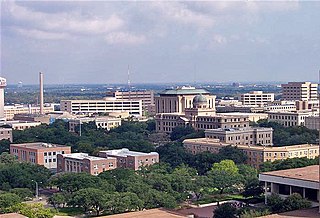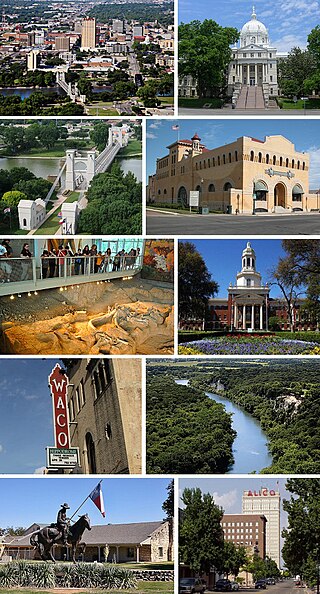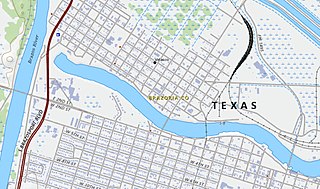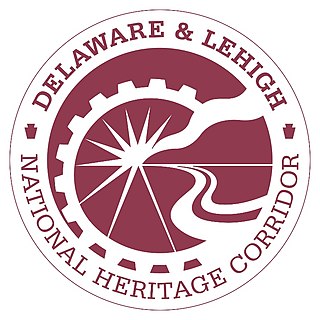
College Station is a city in Brazos County, Texas, United States, situated in East-Central Texas in the Brazos Valley, towards the eastern edge of the region known as the Texas Triangle. It is 83 miles northwest of Houston and 87 miles (140 km) east-northeast of Austin. As of the 2020 census, College Station had a population of 120,511. College Station and Bryan make up the Bryan-College Station metropolitan area, the 15th-largest metropolitan area in Texas with 268,248 people as of 2020.

Ennis is a city in eastern Ellis County, Texas, United States. The population is 20,159 according to the 2020 census, with an estimated population of 21,210 in 2021. Ennis is home to the annual National Polka Festival.

Waco is a city in and the county seat of McLennan County, Texas, United States. It is situated along the Brazos River and I-35, halfway between Dallas and Austin. The city had a U.S. census estimated 2023 population of 144,816, making it the 24th-most populous city in the state. The Waco metropolitan statistical area consists of McLennan, Falls and Bosque counties, which had a 2020 population of 295,782. Bosque County was added to the Waco MSA in 2023. The 2023 U.S. census population estimate for the Waco metropolitan area was 304,865 residents.

East Texas is a broadly defined cultural, geographic, and ecological region in the eastern part of the U.S. state of Texas that comprises most of 41 counties. It is primarily divided into Northeast and Southeast Texas. Most of the region consists of the Piney Woods ecoregion. East Texas can sometimes be defined only as the Piney Woods. At the fringes, towards Central Texas, the forests expand outward toward sparser trees and eventually into open plains.

Washington-on-the-Brazos is an unincorporated community along the Brazos River in Washington County, Texas, United States. The town is best known for being the site of the Convention of 1836 and the signing of the Texas Declaration of Independence.
This article traces the history of Dallas, Texas,.

Velasco was a town in Texas, United States, that was later merged with the city of Freeport by an election conducted by eligible voters of both municipalities on February 9, 1957. The consolidation effort passed by a margin of 17 votes. Founded in 1831, Velasco is situated on the east side of the Brazos River in southeastern Texas. It is 16 miles (26 km) south of Angleton, and 4 miles (6.4 km) from the Gulf of Mexico.

The Drake Well Museum and Park is a museum in Cherrytree Township, Pennsylvania that chronicles the birth of the American oil industry in 1859 by Colonel Edwin Drake. The museum collects and preserves related artifacts. The reconstructed Drake Well demonstrates the first practical use of salt drilling techniques for the extraction of petroleum through an oil well.

The Texas Historical Commission is an agency dedicated to historic preservation within the U.S. state of Texas. It administers the National Register of Historic Places for sites in Texas.

The Gulf, Colorado and Santa Fe Railway was a subsidiary of the Atchison, Topeka & Santa Fe Railway. From its starting point in Galveston, Texas, the railroad eventually extended northwestwards across the state to Sweetwater and northwards via Fort Worth to Purcell, Oklahoma.

Delaware & Lehigh Canal National and State Heritage Corridor (DLNHC) is a 165-mile (266 km) National Heritage Area in eastern Pennsylvania in the United States. It stretches from north to south, across five counties and over one hundred municipalities. It follows the historic routes of the Lehigh and Susquehanna Railroad, Lehigh Valley Railroad, the Lehigh Navigation, Lehigh Canal, and the Delaware Canal, from Bristol northeast of Philadelphia to Wilkes-Barre in the northeastern part of the state.

The forests in the U.S. state of Texas have been an important resource since its earliest days and have played a major role in the state's history. The vast woodlands of the region, home to many varieties of wildlife before Europeans first showed up, provided economic opportunities for early settlers. They continue to play an important role economically and environmentally in the state.

Caddo Mounds State Historic Site (41CE19) is an archaeological site in Weeping Mary, Texas. This Caddoan Mississippian culture site is composed of a village and ceremonial center that features two earthwork platform mounds and one burial mound. Located on a precontact Native American trail later named by the Spanish as El Camino Real de los Tejas, the settlement developed hundreds of years before the arrival of Europeans to the region. Archaeologists believe the site was created in approximately 800 CE, with most major construction taking place between 1100 and 1300 CE.
The Texas Forts Trail is a nonprofit organization chartered in 1999 which promotes heritage tourism, economic development, and historic preservation. It is one of 10 driving trail regions which make up the award-winning Texas Heritage Trails Program of the Texas Historical Commission. The driving trail is 650 miles (1,050 km) long.
The Texas Forest Trail is a non-profit organization which promotes heritage tourism, economic development, and historic preservation. The organization is one of ten driving trail regions which make up the award-winning Heritage Trails Program of the Texas Historical Commission.
The Texas Hill Country Trail is a non-profit organization which promotes heritage tourism, economic development, and historic preservation. It is one of ten regions which make up the Texas Heritage Trails Program of the Texas Historical Commission.
The Texas Independence Trail is a non-profit organization which promotes heritage tourism, economic development, and historic preservation. It is one of ten regions which make up the Texas Heritage Trails Program of the Texas Historical Commission.
The Texas Lakes Trail is a non-profit organization which promotes heritage tourism, economic development, and historic preservation. It is one of ten regions which make up the Texas Heritage Trails Program of the Texas Historical Commission.

The Red Men Museum and Library is an American history museum in Waco, Texas. It also houses the archives and presents the official history of the Improved Order of Red Men, a patriotic fraternal organization with traditions attributed to Native Americans.













